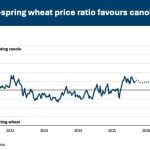The federal government has set an ambitious target of increasing the value of food exports by close to 80 percent during the next eight years.
In an outlook presented to Parliament, Agriculture Canada made much of its plans to aggressively promote expanded trade.
It promised to negotiate more market access into foreign markets, to promote exports of value-added products and to push the Canadian food sector to become more competitive.
It also promised to make sure other countries honor their trade agreement commitments to reduce subsidies and barriers “and that Canadian producers are protected from unfair competition from imports.”
Read Also

Farmers urged to be grain-safe this fall
Working around grain bins comes with risk, from farmers falling to drowning in grain: Experts have five tips to help avoid grain-related accidents this harvest.
All this means the federal government is sharply increasing its goal for export expansion, set in 1993 at $20 billion by 2000. That goal was met in 1996 and surpassed last year.
The department said it will work with the industry “in its efforts to achieve, by the year 2005, its export targets of four percent share of the value of world agriculture and agri-food exports, which translates into $40 billion if current trends continue.”
The department also set as a goal to see processed food products account for 60 percent of exports by 2005, compared to 40 percent a decade earlier.
“Global excellence is about our international trade and our burgeoning markets, from Taiwan to the Ukraine,” agriculture minister Lyle Vanclief said in an introduction to his department’s plan. He promised a continued government commitment to research and to “responsive, efficient safety nets.”
But all that is going to happen with much less government financial support.
The planning outline projected that net program spending by Agriculture Canada will fall almost 32 percent during the next three years.
Drop in spending
From $1.645 billion expected to have been spent in the fiscal year which ended March 31, 1998, the department is projecting net program spending will fall to $1.12 billion in the fiscal year 2000-01, assuming federal safety net and adaptation funding is continued.
For supply management, the government promised nothing but more uncertain change as markets open up and border protections fall.
The government also projected more raw product production and processing because the supply management system will become more “responsive” and because the declining dairy subsidy will disappear in 2001-02.














